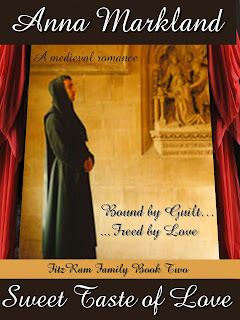As I mentioned previously, my latest release, SweetTaste of Love, is set partially in Lindisfarne Abbey where the monks became
famous for their honey and mead. Below is a medieval recipe for mead, and the
translation, though it’s fun to try to decipher it before peeking!
There are several videos on You-Tube which demonstrate how
to make mead, including a recipe from 1593 for Burnt
Mead.
Mead is also known in some places as Hydromel.
Considering the possibility that a crude form of the drink could easily have spontaneously occurred through ingress of water and naturally occurring yeast, mead may have been the first alcoholic beverage to pass the lips of man.
Known by many names and as different as individual snowflakes, Mead is a global beverage. Predating both grape wine and beer, it's known in various forms on every continent on Earth. Mead is perhaps best known as the preferred drink of Vikings and Celts, beloved by re-enactors everywhere as the authentic drink of the medieval times.
Mead was traditionally drunk by a newly-married couple
on their wedding night, and the hero and heroine of another of my books follow
this custom (Ram and Mabelle in Conquering Passion), though Mabelle is too
nervous to drink hers. Ram makes a chauvinistic comment (somewhat typical for
him) and she ends up hoping he will choke on his mead!
There are different types of mead, including meth and metheglin, which was enriched with finer herbs and spices, as the Cellarer of Lindisfarne,
Brother Tristan explains to our hero, Aidan:
“...ordinary meth for the
common folk and metheglin for the nobility.”
Aidan suspected some of
the latter would find its way into the hands of the Abbot and his cronies. “What’s
the difference?”
Brother Tristan put a
finger to his chapped lips and looked around. “Lavender, and sometimes
rosemary,” he whispered with a conspiratorial wink...
Mead cannot be made without yeast. In the middle ages there
were many natural yeasts used which just floated in the air. People sometimes
called the yeast godisgood, because
without it there would be no fermentation and it was considered a boon from
God. Yeast was more frequently referred to as barm, particularly in the north of England. I can recall as a child
enjoying warm barm cakes, as does our heroine in Sweet Taste of Love, Nolana
Kyncade.
This is the first time I have introduced a Scot into one of my
stories, so I hope you like Nolana. Though Aidan’s father, (Caedmon, from A Man of Value) was born in Scotland, he was a Saxon and never considered himself a
Scot!
(from "Tractatus de magnete et operationibus
eius")
ffor to make mede. Tak
.i. galoun of fyne hony and to þat .4. galouns of water and hete þat water til
it be as lengh þanne dissolue þe hony in þe water. thanne set hem ouer þe fier
& let hem boyle and ever scomme it as longe as any filthe rysith þer on.
and þanne tak it doun of þe fier and let it kole in oþer vesselle til it be as
kold as melk whan it komith from þe koow. than tak drestis of þe fynest ale or
elles berme and kast in to þe water & þe hony. and stere al wel to gedre
but ferst loke er þu put þy berme in. that þe water with þe hony be put in a
fayr stonde & þanne put in þy berme or elles þi drestis for þat is best
& stere wel to gedre/ and ley straw or elles clothis a bowte þe vessel
& a boue gif þe wedir be kolde and so let it stande .3. dayes & .3.
nygthis gif þe wedir be kold And gif it be hoot wedir .i. day and .1. nyght is
a nogh at þe fulle But ever after .i. hour or .2. at þe moste a say þer of and
gif þu wilt have it swete tak it þe sonere from þe drestis & gif þu wilt
have it scharpe let it stand þe lenger þer with. Thanne draw it from þe drestis
as cler as þu may in to an oþer vessel clene & let it stonde .1. nyght or
.2. & þanne draw it in to an oþer clene vessel & serve it forth.
For to make mead. Take
1 gallon of fine honey and to that 4 gallons of water and heat that water till
it be as long. Then dissolve the honey in the water, then set them over the
fire and let them boil and ever scum it as long as any filth rises thereon.
Then take it down off
the fire and let it cool in another vessel till it be as cold as milk when it
comes from the cow. Then take lees from the finest ale or else barm (yeast) and
cast it into the water and honey and stir all well together, but first look
before putting your yeast in that the water with the honey be put in a clean
tub and then put in your yeast or else the lees for that is best and stir well
together.
Lay straw or else
cloths about the vessel and above if the weather is cold and so let it stand 3
days and 3 nights if the weather is cold. And if it is hot weather, 1 day and 1
night is enough at the full. But ever after 1 hour or 2 at the most assay
thereof and if you will have it sweet take it the sooner from the lees and if
you will have it sharp let it stand the longer therewith.
Then draw it from the
lees as clear as you may into another vessel clean and let it stand 1 night or
2 and then draw it into another clean vessel and serve it forth.
Cheers!For links to more interesting articles on Mead click here.




















